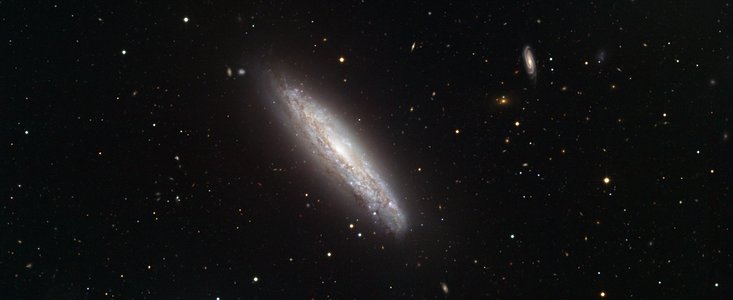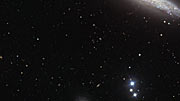Press Release
The Superwind Galaxy NGC 4666
1 September 2010
The galaxy NGC 4666 takes pride of place at the centre of this new image, made in visible light with the Wide Field Imager on the MPG/ESO 2.2-metre telescope at the La Silla Observatory in Chile. NGC 4666 is a remarkable galaxy with very vigorous star formation and an unusual “superwind” of out-flowing gas. It had previously been observed in X-rays by the ESA XMM-Newton space telescope, and the image presented here was taken to allow further study of other objects detected in the earlier X-ray observations.
The prominent galaxy NGC 4666 in the centre of the picture is a starburst galaxy, about 80 million light-years from Earth, in which particularly intense star formation is taking place. The starburst is thought to be caused by gravitational interactions between NGC 4666 and its neighbouring galaxies, including NGC 4668, visible to the lower left. These interactions often spark vigorous star-formation in the galaxies involved.
A combination of supernova explosions and strong winds from massive stars in the starburst region drives a vast flow of gas from the galaxy into space — a so-called “superwind”. The superwind is huge in scale, coming from the bright central region of the galaxy and extending for tens of thousands of light-years. As the superwind gas is very hot it emits radiation mostly as X-rays and in the radio part of the spectrum and cannot be seen in visible light images such as the one presented here.
This image was made as part of a follow-up to observations made with the ESA XMM-Newton space telescope in X-rays. NGC 4666 was the target of the original XMM-Newton observations, but thanks to the telescope’s wide field-of-view many other X-ray sources were also seen in the background. One such serendipitous detection is a faint galaxy cluster seen close to the bottom edge of the image, right of centre. This cluster is much further away from us than NGC 4666, at a distance of about three billion light-years.
In order to fully understand the nature of astronomical objects, researchers must study them at several wavelengths. This is because light of different wavelengths can tell us about different physical processes taking place. In this case the Wide Field Imager (WFI) [1] observations were made in visible light to further investigate these serendipitously detected X-ray objects — a good example of how astronomers using different telescopes work together to explore the Universe.
Notes
[1] The WFI is a joint project between the European Southern Observatory (ESO), the Max-Planck-Institut für Astronomie (MPIA) in Heidelberg (Germany) and the Osservatorio Astronomico di Capodimonte (OAC) in Naples (Italy).
More information
ESO, the European Southern Observatory, is the foremost intergovernmental astronomy organisation in Europe and the world’s most productive astronomical observatory. It is supported by 14 countries: Austria, Belgium, Czechia, Denmark, France, Finland, Germany, Italy, the Netherlands, Portugal, Spain, Sweden, Switzerland and the United Kingdom. ESO carries out an ambitious programme focused on the design, construction and operation of powerful ground-based observing facilities enabling astronomers to make important scientific discoveries. ESO also plays a leading role in promoting and organising cooperation in astronomical research. ESO operates three unique world-class observing sites in Chile: La Silla, Paranal and Chajnantor. At Paranal, ESO operates the Very Large Telescope, the world’s most advanced visible-light astronomical observatory and VISTA, the world’s largest survey telescope. ESO is the European partner of a revolutionary astronomical telescope ALMA, the largest astronomical project in existence. ESO is currently planning a 42-metre European Extremely Large optical/near-infrared Telescope, the E-ELT, which will become “the world’s biggest eye on the sky”.
Links
- Science paper: A&A 449, 837
- Image of the galaxy in X-rays
Contacts
Richard Hook
ESO La Silla/Paranal & E-ELT Public Information Officer
Garching bei München, Germany
Tel: +49 89 3200 6655
Email: rhook@eso.org
Jörg Dietrich
Physics Department, University of Michigan
USA
Tel: +1 734 615 4256
Email: jorgd@umich.edu
About the Release
| Release No.: | eso1036 |
| Name: | NGC 4666 |
| Type: | Local Universe : Galaxy : Activity : Starburst |
| Facility: | MPG/ESO 2.2-metre telescope |
| Instruments: | WFI |
| Science data: | 2006A&A...449..837D |




